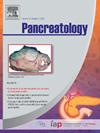Increased kidney stone risk following total pancreatectomy with islet autotransplantation
IF 2.8
2区 医学
Q2 GASTROENTEROLOGY & HEPATOLOGY
引用次数: 0
Abstract
Background/objectives
Chronic pancreatitis (CP) is associated with increased risk of calcium-oxalate kidney stones, likely due to enteric hyperoxaluria. However, the risk of kidney stones for patients with CP after total pancreatectomy with islet autotransplantation (TPIAT) is unknown. We aimed to evaluate kidney stone risk in patients with CP after TPIAT.
Methods
A retrospective analysis of 629 patients who underwent TPIAT was conducted to identify patients who developed kidney stones post-TPIAT. Kaplan-Meier analysis estimated time to first event. An Anderson-Gill proportional-hazards analysis of all kidney stone events described key clinical associations.
Results
Mean age at TPIAT was 33 years (SD 15.3, range 3–69); 69.8 % (n = 439) were female. The estimated chance of any kidney stone episodes by 5 years post-TPIAT was 12.8 % (95 % CI: 8.8–16.6 %); by 10 years, 23.2 % (CI: 17.5–28.6 %); by 15 years, 29.4 % (CI: 21.8–36.2 %). Significant associations with kidney stones post-TPIAT included older age (HR 1.25 per 10 years), smoking history (HR 1.72), mild chronic kidney disease (HR 1.96), renal cysts (HR 3.67), pre-TPIAT kidney stones (HR 4.06), family history of kidney stones (HR 4.10), and Roux-en-Y reconstruction (HR 2.68). Of the 77 patients who developed kidney stones, 34 (44.1 %) had recurrent episodes. Of 143 total kidney stone events, 35 (24.5 %) required stone removal, 79 (55.2 %) resolved spontaneously, and 29 (20.3 %) were missing this data.
Conclusions
Patients with CP post-TPIAT commonly have kidney stones: nearly 3 in 10 have ≥1 kidney stone episodes within 15 years. Clinicians should be aware of this risk and counsel patients on prevention.
胰岛自体移植全胰切除术后肾结石风险增加。
背景/目的:慢性胰腺炎(CP)与草酸钙肾结石风险增加有关,这可能是由于肠道高草酸尿症所致。然而,全胰腺切除加胰岛自体移植(TPIAT)术后的 CP 患者患肾结石的风险尚不清楚。我们的目的是评估 CP 患者在 TPIAT 术后的肾结石风险:我们对 629 例接受 TPIAT 的患者进行了回顾性分析,以确定 TPIAT 术后出现肾结石的患者。Kaplan-Meier分析估计了首次发病的时间。对所有肾结石事件进行的安德森-吉尔比例危险分析描述了主要的临床关联:TPIAT时的平均年龄为33岁(SD 15.3,范围3-69);69.8%(n = 439)为女性。估计TPIAT后5年内发生肾结石的几率为12.8%(95% CI:8.8-16.6%);10年内为23.2%(CI:17.5-28.6%);15年内为29.4%(CI:21.8-36.2%)。与TPIAT术后肾结石密切相关的因素包括:年龄较大(HR 1.25/10)、吸烟史(HR 1.72)、轻度慢性肾病(HR 1.96)、肾囊肿(HR 3.67)、TPIAT术前肾结石(HR 4.06)、肾结石家族史(HR 4.10)和Roux-en-Y重建术(HR 2.68)。在 77 位患肾结石的患者中,有 34 位(44.1%)反复发作。在总共143例肾结石中,35例(24.5%)需要取出结石,79例(55.2%)自行排石,29例(20.3%)数据缺失:结论:TPIAT术后CP患者通常会患上肾结石:每10名患者中就有近3人在15年内≥1次肾结石发作。临床医生应意识到这一风险,并向患者提供预防建议。
本文章由计算机程序翻译,如有差异,请以英文原文为准。
求助全文
约1分钟内获得全文
求助全文
来源期刊

Pancreatology
医学-胃肠肝病学
CiteScore
7.20
自引率
5.60%
发文量
194
审稿时长
44 days
期刊介绍:
Pancreatology is the official journal of the International Association of Pancreatology (IAP), the European Pancreatic Club (EPC) and several national societies and study groups around the world. Dedicated to the understanding and treatment of exocrine as well as endocrine pancreatic disease, this multidisciplinary periodical publishes original basic, translational and clinical pancreatic research from a range of fields including gastroenterology, oncology, surgery, pharmacology, cellular and molecular biology as well as endocrinology, immunology and epidemiology. Readers can expect to gain new insights into pancreatic physiology and into the pathogenesis, diagnosis, therapeutic approaches and prognosis of pancreatic diseases. The journal features original articles, case reports, consensus guidelines and topical, cutting edge reviews, thus representing a source of valuable, novel information for clinical and basic researchers alike.
 求助内容:
求助内容: 应助结果提醒方式:
应助结果提醒方式:


